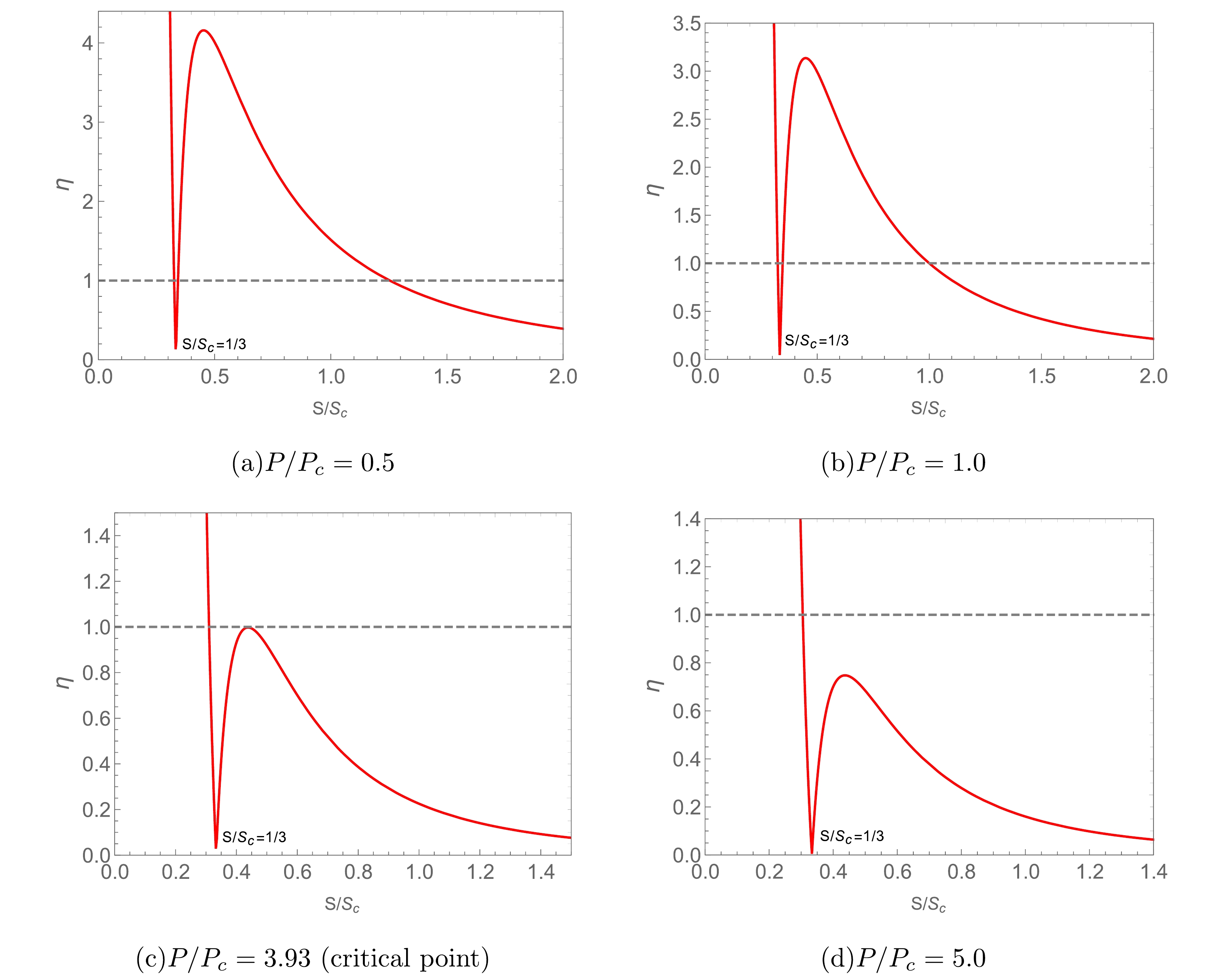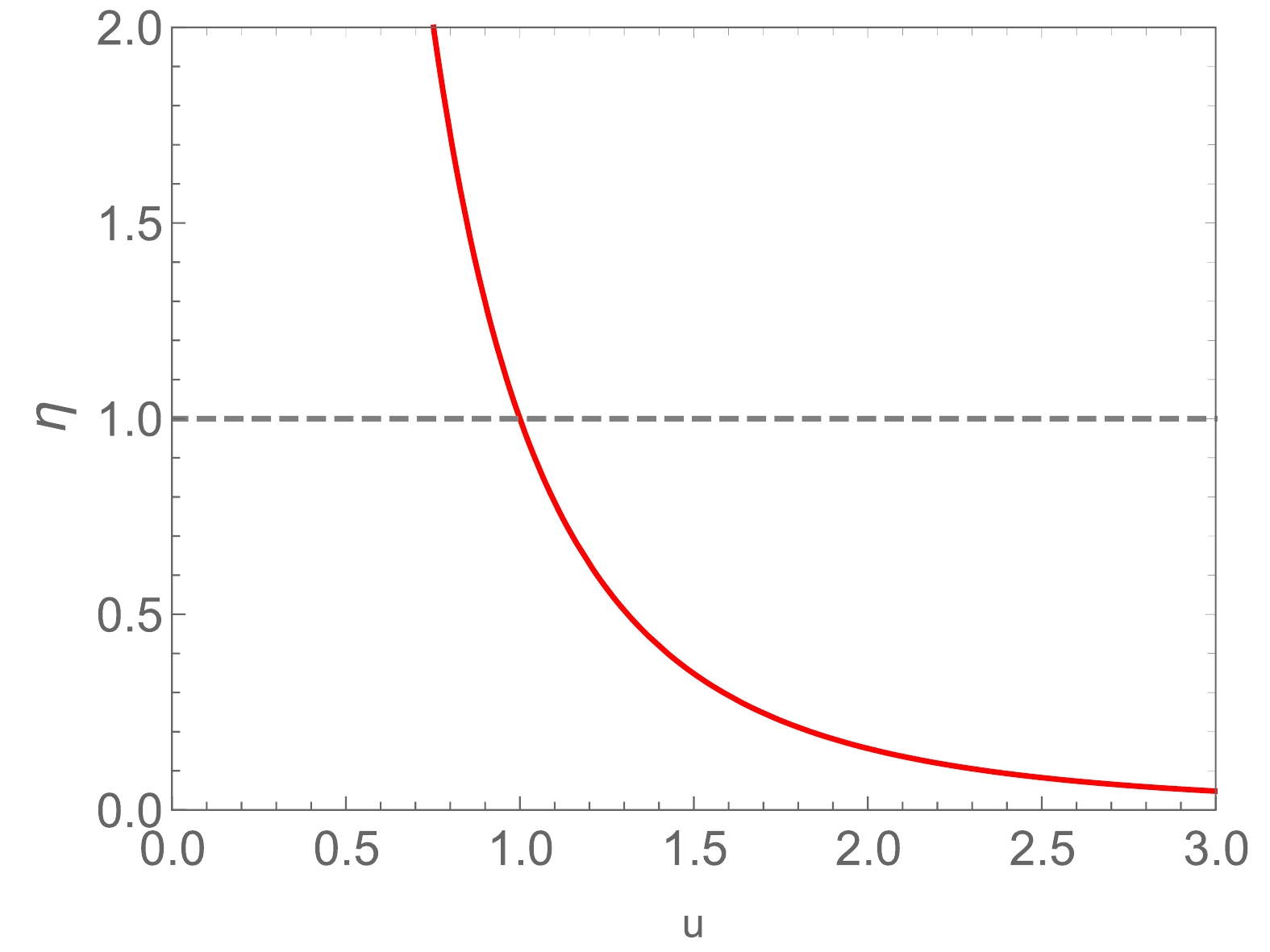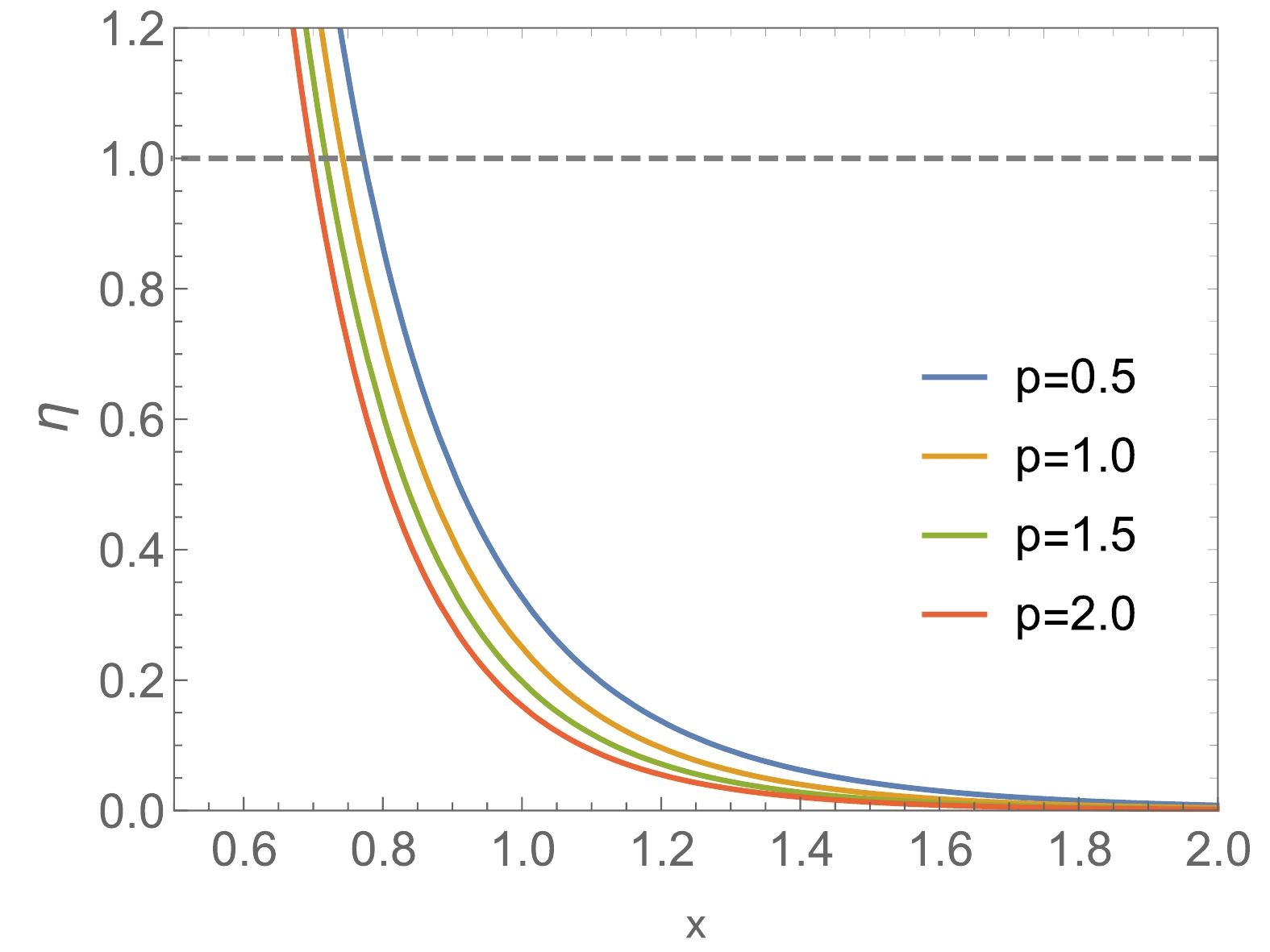HTML
--> --> -->Recently, based on the Ruppeiner thermodynamic geometry [14], a new abstract concept of a "black hole molecule" was proposed [15], which provides a new perspective by which the microscopic behavior of black holes can be studied roughly and phenomenologically. The proponents of this concept describe the interior of a black hole as a kind of fluid composed of black hole molecules that represent its microstructure. This is similar to the atomic hypothesis put forward by Boltzmann more than a century ago. Although we do not know exactly what these black hole molecules are, as a preliminary exploration of black hole microstructure, this abstract concept is very useful for understanding certain microscopic properties of black holes. Among these properties, the role of the Ruppeiner geometry is particularly important. It introduces a thermodynamic metric for representing the thermodynamic fluctuation theory. Meanwhile, the components of the inverse thermodynamic metric correspond to second moments in the fluctuation theory of equilibrium thermodynamics. The original form of the thermodynamic metric is the second derivative of the entropy with respect to other generalized coordinates (or other thermodynamic quantities).
When studying the Ruppeiner geometry of black holes, the thermodynamic curvature is the most important physical quantity. It has two important roles:
● Analyzing the phase transition. The divergence of the thermodynamic curvature is believed to correspond to some kind of phase transition within the system. There are two ways to understand the divergence. On the one hand, the divergence of the thermodynamic curvature corresponds to the configuration of an extremal black hole, or perhaps, the black hole/extremal black hole transition [15-27]. Alternatively, the divergence of the thermodynamic curvature corresponds to the divergence of the heat capacity, i.e., a second-order phase transition [28-37]. However, at present, there is no theoretical requirement that the divergent point of the thermodynamic curvature must correspond to the divergence of the heat capacity or the configuration of an extremal black hole. Irrespective of what the divergent point of the thermodynamic curvature corresponds to, both ideas can be regarded as reasonable and feasible ways to explain the divergent behavior of the thermodynamic curvature.
● Discussing the interaction in a thermodynamic system. As with any new physical quantity, we only care about the role of thermodynamic curvature itself in the context of the microscopic behavior of the system. In certain statistical mechanics models, there is an empirical, yet hypothetical, observation from the view of thermodynamic geometry, that is, the thermodynamic curvature can have a corresponding relationship with the interactions between the constituent molecules of the system [38,39]. However, for the black hole system, the situation is slightly different, and we need to explain the logic for exploring its microscopic behavior. In statistical mechanics, it is generally accepted that if we know the microscopic dynamics of a system, its thermodynamic properties can be derived from the statistical physics of the system. In general, the inverse process does not hold, namely we cannot know the micro-dynamics of the system from its thermodynamics. Turning to the black hole thermodynamic system, although its thermodynamic properties have been discussed at length, its micro-dynamic behavior is still being explored owing to the lack of a theory of quantum gravity. Therefore, if we want to explore the microscopic properties of black holes, we need to make some appropriate assumptions. In comparison with the mature research system of well-established statistical mechanical models, we can consider applying the abovementioned inverse process to the black hole system. Coincidentally, the underlying idea behind this inverse process is reflected in the exploration of the microscopic behavior of black holes by the Ruppeiner thermodynamic geometry. Although certain aspects of this scheme remain the subject of debate within the research community, there appears to be no method that is more suitable from the perspective of thermodynamics. Aided by the abstract concept of the black hole molecule, through analogy, we can assume that there is an interaction among the molecules comprising a black hole, and thus, the above empirical observation also applies to black holes. The physical meaning of the thermodynamic curvature in a black hole system was provided by Ruppeiner [40]. Furthermore, Refs. [19,41] point out that the absolute value of the thermodynamic curvature measures the strength of the interactions among black hole molecules phenomenologically or qualitatively. Recently, for a class of black hole systems with zero heat capacity at constant volume, two methods have been posited to deal with the thermodynamic curvature. The first introduces the normalized thermodynamic curvature by treating the heat capacity at constant volume as a constant very close to zero [41-43]. The second regards the entropy in the thermodynamic metric as a function of the mass (i.e., enthalpy) and other thermodynamic quantities of AdS black holes [24-27]. Both these schemes can well analyze the interaction among molecules of the black hole system.
Therefore, thermodynamic geometry can be considered as one of the best methods for exploring the microscopic properties of black holes solely from the perspective of thermodynamics. Previously, only the positive/negative of the thermodynamic curvature was used to analyze the type of interaction occurring between black hole molecules in the black hole thermodynamic system, while the magnitude of the thermodynamic curvature was used to describe the strength of the interaction qualitatively. We know that, at the microscopic level, the interactions among the constituent molecules of the system always compete with the thermal motion of the molecules themselves. Hence, for the black hole thermodynamic system, this competition should exist. This study focuses on how best to describe this competition.
Under the black hole molecule hypothesis, the product of the temperature and entropy of a black hole can reflect the thermal motion of black hole molecules in terms of the theory of molecular thermal motion. At the same time, using thermodynamic geometry, we can approximate the thermodynamic curvature as a measure of the interactions among black hole molecules. In our previous work [24], via analysis of the microscopic thermal behavior of the Reissner-Nordstr?m black hole, we speculated on the relation between the thermal motion of black hole molecules and their interactions. In this paper, with the help of these two important tools, we propose a preliminary and coarse-grained description of the relation between the interactions among black hole molecules and their thermal motion using the AdS background, taking the AdS black holes as examples, with the aim of elucidating the possible microscopic behavior of black holes. We use the proposed description to identify the transition point between the state dominated by the interaction and that dominated by thermal motion in the black hole system, further revealing the mechanism of black hole phase transition at the microscopic level entirely from the perspective of thermodynamics.
The paper is organized as follows. Section II provides a brief introduction to the Ruppeiner thermodynamic geometry. In section III, we introduce a dimensionless ratio to characterize the relation between the interaction and thermal motion of molecules in AdS black holes. Finally, section IV presents our conclusions.
$ \begin{array}{l} S(x^0,x^1,\cdots) = S_B(x^0,x^1,\cdots)+S_E(x^0,x^1,\cdots), \end{array} $  | (1) |
$ \begin{aligned}[b]S =& S_0+\frac{\partial S_B}{\partial x_B^\mu}\Delta x^\mu_B +\frac{\partial S_E}{\partial x_E^\mu}\Delta x^\mu_E +\frac{1}{2}\frac{\partial^2 S_B}{\partial x_B^\mu \partial x_B^\nu}\Delta x^\mu_B \Delta x^\nu_B \\& +\frac{1}{2}\frac{\partial^2 S_E}{\partial x_E^\mu \partial x_E^\nu}\Delta x^\mu_E \Delta x^\nu_E +\cdots. \end{aligned} $  | (2) |
$ \Delta S = S_0-S \approx -\frac{1}{2}\frac{\partial^2 S_B}{\partial x_B^\mu \partial x_B^\nu}\Delta x^\mu_B \Delta x^\nu_B. $  | (3) |
$ P(x^0,x^1,\cdots)\propto \exp\left(-\frac12 \Delta l^2\right) , $  | (4) |
$ \Delta l^2 = -\frac{\partial^2 S}{\partial x^\mu \partial x^\nu}\Delta x^\mu \Delta x^\nu, $  | (5) |
For a system comprising a black hole and its surrounding infinite environment, the black hole itself is a small subsystem of the above. Returning to the example of an AdS black hole, the first law of thermodynamics is
$ {\rm d}S = \frac{1}{T}{\rm d}M-\frac{V}{T}{\rm d}P, $  | (6) |
$ \Delta l^2 = \frac{1}{T}\Delta T \Delta S+\frac{1}{T}\Delta V \Delta P. $  | (7) |
$ \Delta l^2 = \frac{1}{T}\left(\frac{\partial T}{\partial S}\right)_P \Delta S^2+\frac{2}{T}\left(\frac{\partial T}{\partial P}\right)_S \Delta S \Delta P+\frac{1}{T}\left(\frac{\partial V}{\partial P}\right)_S \Delta P^2, $  | (8) |
In addition, we use the Christoffel symbols,
$ \Gamma^{\alpha}_{\beta\gamma} = \frac12 g^{\mu\alpha}\left(\partial_{\gamma}g_{\mu\beta}+\partial_{\beta}g_{\mu\gamma}-\partial_{\mu}g_{\beta\gamma}\right), $  | (9) |
$ \begin{array}{l} {R^{\alpha}}_{\beta\gamma\delta} = \partial_{\delta}\Gamma^{\alpha}_{\beta\gamma}-\partial_{\gamma}\Gamma^{\alpha}_{\beta\delta}+ \Gamma^{\mu}_{\beta\gamma}\Gamma^{\alpha}_{\mu\delta}-\Gamma^{\mu}_{\beta\delta}\Gamma^{\alpha}_{\mu\gamma}. \end{array} $  | (10) |
$ \begin{array}{l} R = g^{\mu\nu}{R^{\xi}}_{\mu\xi\nu}. \end{array} $  | (11) |
$ \eta: = \frac{\rm{Interaction}}{\rm{Thermal\; motion}} \approx \frac{\rm{The\; magnitude\; of\; thermodynamic\; curvature \times Planck\; volume}}{\rm{Temperature\; \times\; entropy}}. $  | (12) |
● In regular thermodynamics, the key notion used to describe the phase transition is the free energy, which measures the competition between interactions and the thermal motions. In particular, for the free energy, the degree of the thermal motion is measured by the product of the temperature and entropy of the system.
● First, through analysis, it can be seen that the temperature, entropy, and volume have dimensions of
● The dimensions of the numerator and denominator in Eq. (12) are consistent. When the interaction represented by the numerator and the thermal motion represented by the denominator are in balance with each other, the ratio
● If
● If
● If
Next, we use the newly introduced measurement to investigate the microscopic behaviors of several kinds of AdS black holes. In the following discussion, we often set the value of Planck volume as a unit.
2
A.Four-dimensional charged AdS black hole
We start by considering a four-dimensional charged AdS black hole, the metric of which can be expressed as [11,12,30] $ {\rm d} s^2 = -f(r){\rm d}t^2+\frac{{\rm d} r^2}{f(r)}+r^2({\rm d}\theta^2+\sin^2 \theta {\rm d}\varphi^2), $  | (13) |
$ T = \frac{8P S^2+S-\pi q^2}{4S\sqrt{\pi S}}, $  | (14) |
$ R = \frac{2\pi q^2-S}{S(8P S^2+S-\pi q^2)}. $  | (15) |
$ t: = \frac{T}{T_c}, \;\;\;\; s: = \frac{S}{S_c}, \;\;\;\; p: = \frac{P}{P_c}, \;\;\;\; \zeta: = \left|\frac{R}{R_c}\right|, $  | (16) |
$ T_c = \frac{\sqrt{6}}{18\pi q}, \;\;\; S_c = 6\pi q^2, \;\;\; P_c = \frac{1}{96\pi q^2}, \;\;\; R_c = -\frac{1}{12\pi q^2}. $  | (17) |
$ \eta = \left|\frac{32(1-3s)}{\sqrt{s}(3ps^2+6s-1)^2}\right|. $  | (18) |
 Figure1. (color online) The dimensionless ratio
Figure1. (color online) The dimensionless ratio ● For the charged AdS black hole system, there is indeed competition between the interactions among black hole molecules and their thermal motion.
● At
● In B1, we can see that regardless of the value of the dimensionless pressure
● In B2, as the dimensionless entropy
2
B.Four-dimensional Schwarzschild-AdS black hole
The Schwarzschild-AdS black hole is a special case of the charged AdS black hole for which $ T = \frac{8P S+1}{4\sqrt{\pi S}}, \;\;\;\; R = -\frac{1}{8P S^2+S}. $  | (19) |
$ t = \frac{T}{\sqrt{8\pi P}} = \frac{u+1}{4\pi\sqrt{u}}, \;\;\; s = 8\pi PS = \pi u, \;\;\; \zeta = \left|\frac{R}{8P}\right| = \frac{1}{u(u+1)}. $  | (20) |
$ \eta = \frac{4}{u^{3/2}(u+1)}. $  | (21) |
 Figure2. (color online) The dimensionless ratio
Figure2. (color online) The dimensionless ratio 2
C.Five-dimensional Gauss-Bonnet AdS black hole
The metric of the Gauss-Bonnet AdS black hole in $ {\rm d}s^2 = -f(r){\rm d}t^2+\frac{1}{f(r)}{\rm d}r^2+r^2 {\rm d}\Omega^2, $  | (22) |
$ f(r) = 1+\frac{r^2}{2\alpha_0}\left(1-\sqrt{1+\frac{64\pi\alpha_0 {\cal M}}{(d-2)r^{d-1}\Sigma}-\frac{64\pi\alpha_0 P}{(d-1)(d-2)}}\right), $  |
When
$ T = \frac{8\pi P r_h^3+3r_h}{6\pi(r_h^2+2\alpha_0)}, \qquad S = \frac{\pi^2 r_h(r_h^2+6\alpha_0)}{2}. $  | (23) |
$ R = -\frac{4}{\pi^2 r_h(r_h^2+2\alpha_0)(8\pi P r_h^2+3)}. $  | (24) |
$ t = \frac{p x^3+3x}{3x^2+1}, \;\;\; s = \frac{x^3+x}{2}, \;\;\; \zeta = \frac{4}{(3x^2+1)(p x^3+3x)}, $  | (25) |
$ \begin{aligned}[b] T_c =& \frac{1}{2\pi\sqrt{6\alpha_0}}, \;\;\; r_c = \sqrt{6\alpha_0}, \;\;\; S_c = 6 \pi^2 \alpha_0 \sqrt{6\alpha_0}, \\ P_c =& \frac{1}{48\pi \alpha_0}, \;\;\; R_c = -\frac{1}{8\pi^2 \alpha_0 \sqrt{6\alpha_0}}. \end{aligned} $  |
$ \eta = \frac{8}{(p x^3+3x)^2(x^3+x)}. $  | (26) |
 Figure3. (color online) The dimensionless ratio
Figure3. (color online) The dimensionless ratio In this paper, using the concept of black hole molecules, we introduce a dimensionless ratio (Eq. (12)) to characterize the relation between the interactions and the thermal motion of the AdS black holes. Using this preliminary and coarse-grained description, we find that there is indeed competition between the interactions among black hole molecules and their thermal motion. As such, we present the following conclusions:
● For the charged AdS black hole, the microscopic behaviors of the black hole can be divided into two branches (B1 and B2). In B1, the black hole always experiences a transition from the interaction state to the thermal motion state, whereas in B2, the transition point between the interaction state and the thermal motion state depends on the value of the dimensionless pressure
● For the Schwarzschild-AdS black hole, there is always a transition between the interaction state and the thermal motion state. Meanwhile, the transition point satisfies
● For the five-dimensional Gauss-Bonnet AdS black hole, a transition always occurs between the interaction state and the thermal motion state.
In addition, our current approach is extendable to other types of black holes, such as (charged) Kerr (-AdS) black holes, thereby offering a versatile approach to analyze certain new microscopic thermal information of various black holes.
